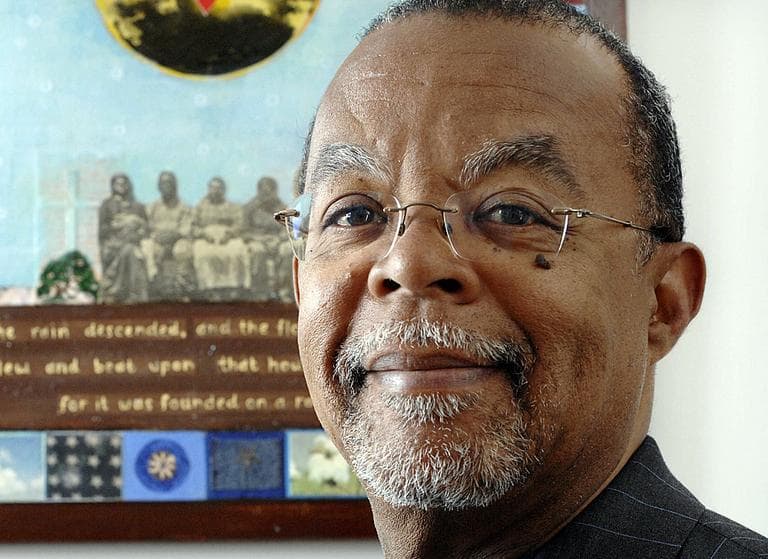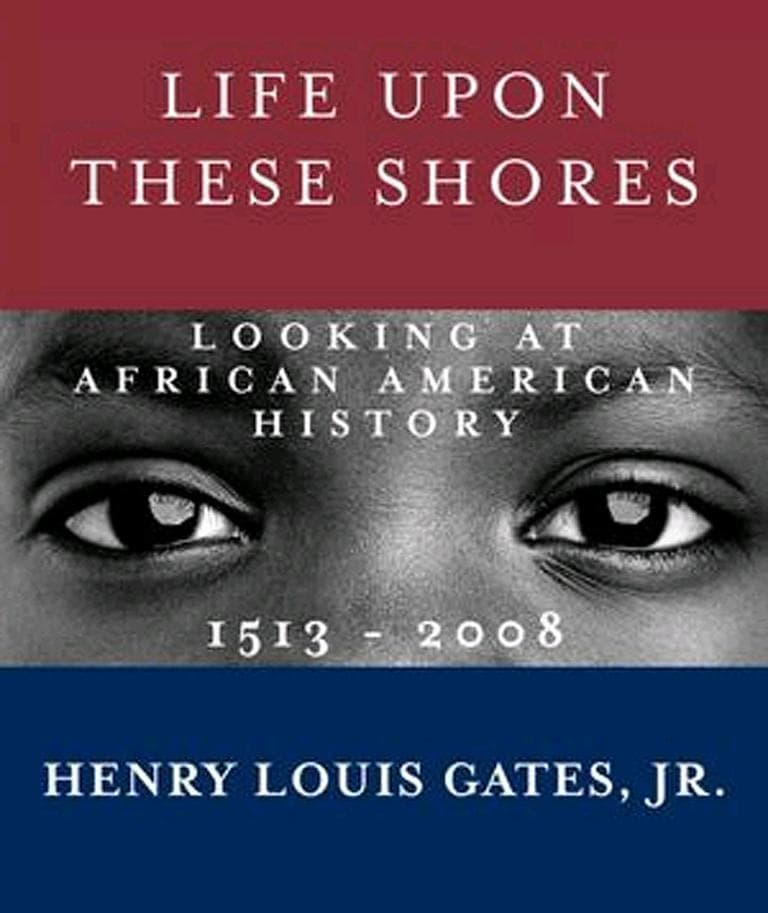Advertisement
Henry Louis Gates Jr. On 'Life Upon These Shores'

Henry Louis Gates, Jr. is one of America's most prominent public intellectuals. The Harvard professor is the director of the W.E.B. Du Bois Institute for African and African American Research. He's also author of many books on black culture and black history. And probably most widely known for his PBS documentaries, "Faces of America" and "African American Lives," that weave together genetics and genealogy to reveal the surprising ancestral stories of renowned black Americans.
He's used that same forensic curiosity in his new book, one that takes on the entire sweep of American history. It's called: "Life Upon These Shores: Looking at African American History, 1513-2008."
Guest:
- Henry Louis Gates, Jr., director of the W.E.B. Du Bois Institute for African and African American Research, Harvard University
---
Excerpt: "Life Upon These Shores: Looking At African American History, 1513-2008"
INTRODUCTION

Before the pen of Jefferson etched the majestic words of the Declaration of Independence across the pages of history, we were here. For more than two centuries our forebears labored without wages; they made cotton king . . .—and yet out of a bottomless vitality, they continued to thrive and develop. If the inexpressible cruelties of slavery could not stop us, the opposition we now face will surely fail . . . because the goal of America is freedom. Abused and scorned though we may be, our destiny is tied up with America’s destiny.
—Martin Luther King, Jr. “Letter from Birmingham Jail,” April 16, 1963
In "Life Upon These Shores," I set out to picture African American history, to find a new way of looking at its full sweep. I imagined a book with an abundance of images of the great and small events and of the signifi cant individuals who shaped the heritage of the African American people and the history of our nation. "Life Upon These Shores: Looking at African American History" draws upon a treasury of illustrations at once to visualize and to write the history of black people in America, which begins as early as 1513, when the free black conquistador Juan Garrido accompanied Ponce de León on his first expedition to Florida. So the book ranges from the exploration of the New World and the long ordeal of slavery through Emancipation and the Civil War; from the era of Reconstruction through Jim Crow and World War I; from the Great Migration of 1910 to 1930—including the Harlem Renaissance and the Jazz Age— through the Great Depression and World War II; from the civil rights movement and its aftermath, and the Black Power insurgence, on to the age of hip-hop and the rise of the Joshua Generation, leading to the election of the first African American president of the United States. "Life Upon These Shores" illustrates the richness of this history through ancient maps, manuscripts and documents, portraits, postcards, posters, sheet music, cartoons, drawings and photographs, and even film stills.
Advertisement
We have combed through more than four hundred years of public records and private collections for the names, stories, and images of not only well-known African Americans but also others who have been consigned to oblivion even as they too were instrumental in shaping African American history day to day. To be sure, here are the transcendent personalities: among many, Phillis Wheatley, Sojourner Truth, Henry Highland Garnet, Harriet Tubman, Anna Julia Cooper, Ida B. Wells, Booker T. Washington, Frederick Douglass, Madam C. J. Walker, Jack Johnson and Joe Louis, W. E. B. Du Bois, Alain Locke, Langston Hughes, Josephine Baker, George Schulyer, Zora Neale Hurston, Richard Wright, Ralph Ellison, Althea Gibson and Arthur Ashe, Charles Hamilton Houston, Thurgood Marshall, Constance Baker Motley, Elijah Muhammad and Muhammad Ali, Adam Clayton Powell, Martin Luther King, Jr., Malcolm X, John Lewis, James Meredith, Charlayne Hunter-Gault, James Baldwin, Eldridge Cleaver, Huey P. Newton, Stokely Carmichael, H. Rap Brown, James Brown, Amiri Baraka, Shirley Chisholm, Jesse Jackson, Michael Jackson and Prince, Colin Powell, Condoleezza Rice, and Barack Obama. Their vaunted contributions to politics, sports, literature, the arts, religion, and education have indelibly colored the canvas of American culture and society. But this book also aims in part to restore to the historical record the names and achievements of significant men and women long forgotten: among them Onesimus, the slave who taught Cotton Mather to inoculate the Massachusetts colony against smallpox; the pre–Civil War, wildly popular black ventriloquist and magician Richard Potter; Stagecoach Mary, a post– Civil War driver for Wells Fargo; and the famous cowboy Deadwood Dick.
As I have studied the remarkable visual depictions collected in Life Upon These Shores, I have been struck by the sheer diversity of African American expression throughout our nation’s history— how there has never been only one way to be black, religiously, politically, socially, artistically, professionally, sexually, or stylistically. I have tried to showcase the multiplicity of cultural institutions, political strategies, and religious and social perspectives defi ning black culture and society from slavery to freedom, from the plantation to the White House. Although, for example, debates between such central figures as Booker T. Washington and W. E. B. Du Bois, or Malcolm X and Martin Luther King, Jr., are familiar in the academy, they remain largely unknown to the general public, as do controversies involving their lesser-known peers; the latter too have a place at the table. These and all the other images and stories in this book help us to understand the complexity of the African American people, the rich and honest diversity of opinion that has always characterized the black experience in America.
"Life Upon These Shores" seeks not only to elucidate the pressing issues faced by each generation of African Americans but also to evoke the limitless variety of African American life: for instance, the experience of slavery in the North as opposed to slavery on a Southern plantation or in the West; the experience of being a freedperson as opposed to a slave; the experience of being a sharecropper in the South in the early twentieth century as opposed to a dockworker in Oakland or an autoworker in Detroit; the experience of being a black woman as opposed to a black man. Here are images of African Americans from different African ethnic groups dragged into slavery, forced to imagine new identities upon these shores; images of free blacks alongside their enslaved brethren in the South, forming their own religious, social, and cultural institutions in the North; images documenting the myriad ways in which some resisted slavery and segregation even as others sought accommodation, all the while forging family ties and communal bonds “behind the veil,” as W. E. B. Du Bois put it.
The illustrations also offer a glimpse at how global affairs infl uenced African American history. So it was that the Haitian Revolution (1791–1804) sparked demands for the abolition of slavery and for equal rights up through the Civil War, while inspiring slave rebellions in America. A century and a half or so later, African movements for independence from colonialism informed the American civil rights movement, which in turn was to have a profound infl uence on the release of Nelson Mandela from prison and the dismantling of apartheid in South Africa.
A collective visual history of persons of African descent in America since their arrival in the sixteenth and seventeenth centuries, Life Upon These Shores— by examining defi ning issues, controversies and debates, and the achievements of people who shaped the history day to day for more than four hundred years—reveals, in all its human glory, the generally unacknowledged multifaceted nature of the black experience in these United States.
This is a general history for a general audience and relies on an enormous body of scholarly literature. The book stands on the shoulders of true giants. To retain its appeal, I have limited intrusive scholarly apparatus and identified sources only for direct quotes or for information not readily accessible. For those seeking verification of facts or additional information, one should consult the extended bibliography, which lists all of the major works used in this study.
Henry Louis Gates , Jr.
Oak Bluffs, Massachusetts
August 31, 2010
This program aired on December 1, 2011.